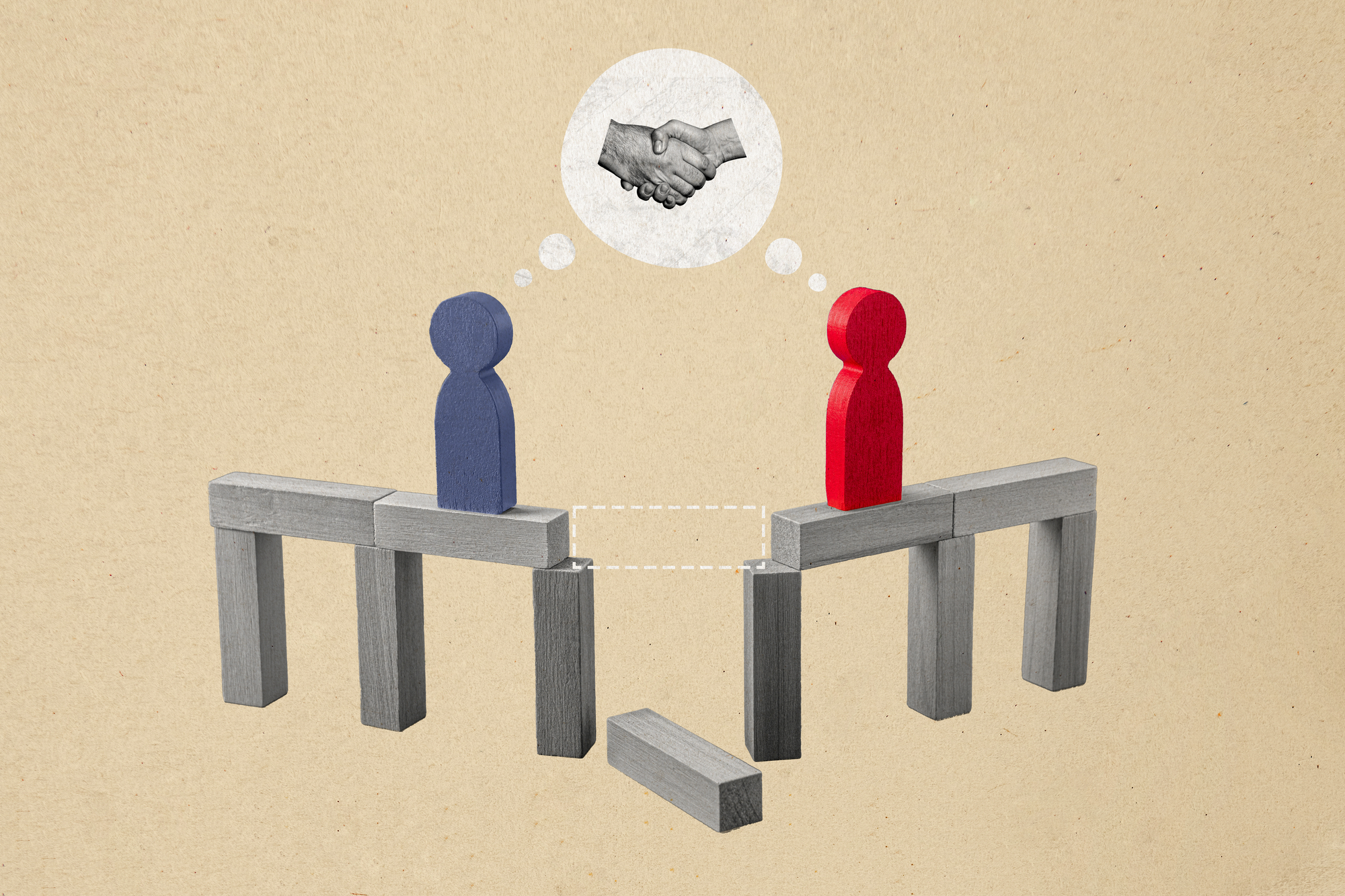Don’t let differences of opinion fuel hatred in your heart.

In a world of diverse opinions and beliefs, navigating relationships with those we fundamentally disagree with can be challenging. Yet, it’s a crucial skill for fostering harmony and inner peace. By embracing empathy, open-mindedness, and respect, we can build bridges across ideological divides and create meaningful connections. Or at least not fight everyone whose views clash with our own.
1. Separate the person from their beliefs.

If you take just one piece of advice from this article, make it this one: a person is more than just their opinions or beliefs, so treat them as such.
By separating individuals from their ideas, we open doors to genuine connections. It’s about seeing the human behind the viewpoint, complete with their own experiences, fears, and hopes. This approach allows us to maintain respect for the person, even when we vehemently disagree with their stance.
2. Do not allow yourself to think that they are “worse” and you are “better” simply because of your views.

Holding a particular belief doesn’t automatically make someone better or worse than anyone else. That can be quite difficult to accept sometimes, particularly if you find another’s views abhorrent. But it’s true.
Our views are shaped by countless factors—upbringing, education, personal experiences, and more. They’re not a measure of our worth as human beings. When we start viewing ourselves as “better,” we close off opportunities for meaningful dialogue and mutual understanding.
Instead, approach differences with humility. Recognize that your perspective, while valid, isn’t the only one. This mindset fosters respect and opens the door to constructive conversations, even amidst disagreement.
3. Avoid using inflammatory language or making personal attacks.

Words can be weapons or bridges, so choose wisely. When discussions heat up, it’s tempting to lob verbal grenades. But inflammatory language and personal attacks only serve to widen the divide and shut down productive dialogue.
Focus on expressing your thoughts clearly and respectfully. Instead of saying, “You’re an idiot for thinking that,” try, “I see things differently, and here’s why.” This approach keeps the conversation centered on ideas rather than personal judgments.
Remember, the goal isn’t to wound or dominate, but to understand and be understood. By keeping your language measured and respectful, you create an environment where both parties feel safe to express themselves honestly.
4. Do not paint all people who hold a particular view with the same brush.

It’s easy to fall into the trap of assuming everyone who holds a certain view thinks and acts the same way. But reality is far more nuanced.
Within any belief system or ideology, there’s a spectrum of thoughts and behaviors. One bad experience with someone who holds a particular view doesn’t define everyone who shares that perspective. By avoiding generalizations, we open ourselves to the rich diversity within groups.
Approach each person as an individual, not a stereotype. You might be surprised at the variety of opinions and experiences you encounter, even among those who seem to share similar beliefs.
5. Know that a person’s views stem from complex forces you likely won’t be able to understand.

Our beliefs are like icebergs—what’s visible is just the tip. Beneath the surface lies a complex web of experiences, influences, and personal history that shape our worldviews. Understanding this can foster empathy and patience in our interactions.
Instead of dismissing someone’s views outright, try to explore the roots. Ask about their experiences and the journey that led them to their current perspective. You might not fully understand or agree, but you’ll gain valuable insight into their thought process.
This approach transforms potentially contentious discussions into opportunities for mutual learning and growth. It’s not about agreeing, but about appreciating the complexity of human belief systems.
6. Know that you might agree on some things, even though you disagree on one or more other things.

Even when we disagree strongly on certain issues, there’s often common ground to be found elsewhere. This realization can be a powerful tool for building bridges and fostering understanding.
By actively seeking areas of agreement, we break free from the “us vs. them” mentality. Maybe you disagree on politics but share a passion for environmental conservation. Or perhaps you have different religious views but both value community service.
These shared values and interests can serve as starting points for meaningful connections. They remind us of our shared humanity and can help soften the edges of our disagreements.
7. Try not to see the disagreement as right versus wrong or good versus bad.

The world rarely fits into neat “right” and “wrong” categories. When we frame disagreements in these terms, we close ourselves off to nuance and alternative perspectives. Instead, try viewing differences as variations in approach or understanding.
This shift in mindset allows for more productive conversations. Rather than trying to prove someone wrong, focus on understanding their perspective. Ask questions, listen actively, and be open to learning something new.
Remember, even if you strongly disagree, the other person’s view likely makes sense to them based on their experiences and knowledge.
8. Be aware of your own biases and how they might influence your perception of others’ views.

We all have biases—they’re part of being human. The key is recognizing and managing them. Our personal experiences, cultural background, and even the media we consume shape how we perceive the world and others’ opinions.
Take time to reflect on your own biases. What assumptions do you make about people who hold different views? How might your background influence your perspective? By acknowledging our biases, we can work to mitigate their impact on our interactions.
This self-awareness allows for more fair and open-minded discussions. It helps us approach differences with humility, recognizing that our view isn’t the only valid one. Questioning your own beliefs doesn’t mean abandoning them—it’s about refining and strengthening your understanding.
9. Do not attempt to “convert” other people—but do state your opinion respectfully.

Engaging with different viewpoints isn’t about winning converts. It’s about fostering understanding and respect. Approaching conversations with the goal of changing someone’s mind often leads to defensiveness and closed-off communication.
Instead, focus on sharing your perspective clearly and respectfully. Explain your reasoning and the experiences that have shaped your views. At the same time, be open to hearing others’ thoughts without feeling the need to counter every point.
This approach creates a more balanced dialogue where both parties feel heard and respected. It allows for the exchange of ideas without the pressure of trying to “win” the conversation.
10. Know that listening to someone explain their views does not mean you’ve endorsed them.

Active listening is a powerful tool for building understanding, but it doesn’t equate to agreement. Many people hesitate to truly hear out opposing views for fear of seeming to endorse them. However, listening is about comprehension, not conversion.
By giving someone your full attention as they explain their perspective, you’re showing respect and openness. This doesn’t mean you’re adopting their views, you’re simply seeking to understand them better.
This willingness to listen can lead to more productive discussions and even find unexpected common ground. It demonstrates maturity and confidence in your own beliefs while fostering an environment of mutual respect.
11. Know that you don’t have to like or be friends with someone to be civil.

Civility doesn’t require friendship or even fondness. In fact, it’s during interactions with those we don’t particularly like that civility becomes most crucial. Think of it as the social lubricant that keeps the gears of society turning smoothly, even when there’s friction.
Being civil means treating others with basic respect and courtesy, regardless of your personal feelings toward them. It’s about maintaining a level of professionalism and human decency in your interactions.
But it doesn’t mean you have to engage in deep conversations or spend significant time with someone you dislike. You can do what needs to be done with this person and then be on your way.
Civility is a choice that reflects more on your character than on the other person’s worthiness. By choosing to be civil, you contribute to a more harmonious society and set a positive example for others to follow. Plus, you never know when you might need to work alongside or interact with this person in the future.









